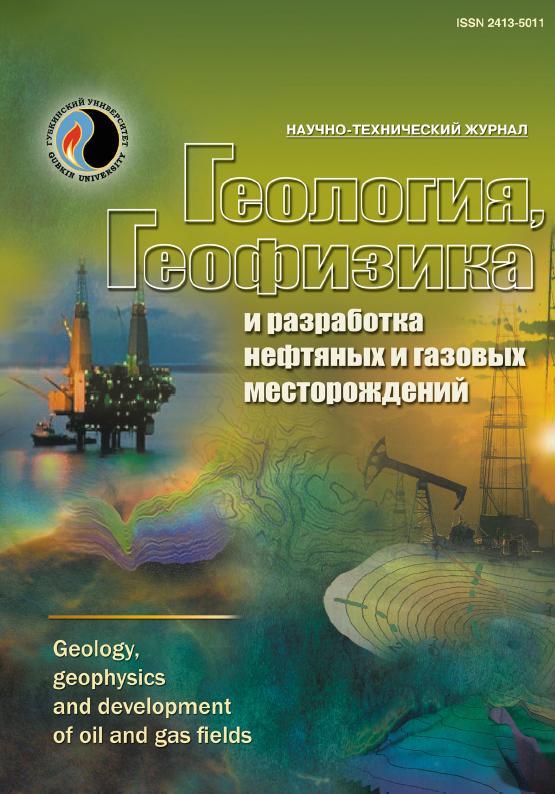Scientific and technical journal
«Geology, geophysics and development of oil and gas fields»
ISSN 2413-5011

Afanaskin I.V., Kryganov P.V., Akhapkin M.Yu., Dyachenko A.G., Chen-len-son Yu.B., Shteinberg Yu.M.
UDC: 622.276.1/.4.001.57
DOI: 10.33285/2413-5011-2022-10(370)-44-56
Authors:
1 Scientific Research Institute for System Analysis of the Russian Academy of Sciences, Moscow, Russia
Keywords: hydrodynamic well testing, convolution, deconvolution, multi-well deconvolution, CRM-model, Buckley – Leverett theory, pressure drawdown curve, well interference test
Annotation:
The article proposes a specially modified CRM-model, which could be applied as an analogue to a multi-well deconvolution of downhole pressure data acquired in a well with increasing water-cut. A CRMsim model was used as the initial modification model. Growing water-cut is accounted on the basis of the historic data by means of productivity coefficient modification.
Six different modification approaches are proposed. To test the above-said approach, the real production data from a well drilled in one of the fields located in Timan-Pechora oil- and gas-bearing region. The testing proved good results. The reservoir characteristics of the near-well and inter-well zones as well as the adjacent wells influence degree on downhole pressure change of the tested well were determined.
Bibliography:
1. Kul’pin L.G., Myasnikov Yu.A. Gidrodinamicheskie metody issledovaniya neftegazovodonosnykh plastov. – M.: Nedra, 1974. – 200 s.
2. Earlougher R.C. Jr. Advances in Well Test Analysis // SPE Monograph Series. – 1977. – Vol. 5. – 264 p.
3. Bourdet D. Well Test Analysis: The Use of Advanced Interpretation Models. – Boston: Elsevier Science, 2002. – 436 р.
4. Von Schroeter T., Hollaender F., Gringarten A.C. Deconvolution of Well-Test Data as a Nonlinear Total Least-Squares Problem // SPE Journal. – 2004. – Vol. 9. – Pp. 375–390.
5. Levitan M.M. Practical Application of Pressure-Rate Deconvolution to Analysis of Real Well Tests SPE Annual Technical Conference and Exhibition. – Colorado: Denver, October 2003.
6. Houze О., Viturat D., Fjaere Ole S. Dynamic Data Analysis. – Kappa Engineering, 2021. – 874 р.
7. Multiwell Deconvolution / J.A. Cumming, D.A. Wooff, T. Whittle, A.C. Gringarten // SPE Reservoir Evaluation & Engineering. – 2014. – Vol. 17. – Рр. 457–465.
8. Zheng Shi-Yi, Wang Fei. Multi-Well Deconvolution Algorithm for the Diagnostic, Analysis of Transient Pressure with Interference from Permanent Down-hole Gauges (PDG) // EUROPEC/EAGE Conference and Exhibition. – The Netherlands: Amsterdam, June 2009.
9. Gulyaev D.N., Batmanova O.V. Impul’sno-kodovoe gidroproslushivanie i algoritmy mul’tiskvazhinnoy dekonvolyutsii – novye tekhnologii opredeleniya svoystv plastov v mezhskvazhinnom prostranstve // Vestnik Ros. novogo un-ta. Ser.: "Slozhnye sistemy: modeli, analiz, upravlenie". – 2017. – № 4. – S. 26–32.
10. Aslanyan A., Aslanyan I., Farakhova R. Application of Multi-Well Pressure Pulse-Code Testing for 3D Model Calibration // SPE Annual Technical Conference and Exhibition. – UAE: Dubai, September 2016.
11. Waterflood Study of High Viscosity Saturated Reservoir with Multiwell Retrospective Testing and Cross-Well Pressure Pulse-Code Testing / A. Aslanyan, I. Kovalenko, I. Ilyasov, D. Gulyaev, А. Buyanov, Kh. Musaleev // SPE International Heavy Oil Conference and Exhibition. – Kuwait: Kuwait City, December 2018.
12. Multiwell Deconvolution for Shale Gas / Y. Tung, C.Virues, J. Cumming, A. Gringarten // SPE Europe featured at 78th EAGE Conference and Exhibition. – Austria: Vienna, May 2016.
13. Issledovanie osobennostey otsenki vzaimovliyaniya skvazhin na primere modeli CRM / A.A. Ruchkin, S.V. Stepanov, A.V. Knyazev [i dr.] // Vestnik Tyumenskogo gos. un-ta. Fiziko-matematicheskoe modelirovanie. Neft’, gaz, energetika. – 2018. –T. 4. – № 4. – S. 148–168.
14. Khatmullin I.F., Andrianova A.M., Margarit A.S. Poluanaliticheskie modeli rascheta interferentsii skvazhin na baze klassa modeley CRM // Neft. khoz-vo. – 2018. – № 12.
15. Prediction of Immiscible Gas Flooding Performance: a Modified Capacitance–Resistance Model and Sensitivity Analysis / S.H. Yousefi, F. Rashidi, M. Sharifi [et al.] // Pet. Sci. – 2019. – Vol. 16. – Pp. 1086–1104.
16. Sayarpour M. Development and Application of Capacitance-Resistive Models to Water/CO2 Floods: Dissertation of the Requirements for the Degree of Doctor of Philosophy // Graduate School of The University of Texas. – 2008. – 236 p.
17. Stepanov S.V., Pospelova T.A. Novaya kontseptsiya matematicheskogo modelirovaniya dlya prinyatiya resheniy po razrabotke mestorozhdeniy // Neft. khoz-vo. – 2019. – № 4. – S. 50–53.
18. Olenchikov D., Posvyanskii D. Application of CRM-Like Models for Express Forecasting and Optimizing Field Development // SPE Russian Petroleum Technology Conference SPE-196893-MS. – Russia: Moscow, 22 – 24 October 2019.
19. Primenenie CRM-modeley dlya mul’tiskvazhinnoy dekonvolyutsii dannykh o zaboynykh davleniyakh i debitakh / I.V. Afanaskin, S.G. Vol’pin, Yu.M. Shteynberg, O.V. Lomakina, D.V. Solopov // Neftepromyslovoe delo. – 2020. – № 11(623). – S. 60–67. – DOI: 10.30713/0207-2351-2020-11(623)-60-67
20. Testirovanie podkhoda k mul’tiskvazhinnoy dekonvolyutsii s ispol’zovaniem CRM-modeley na primere zonal’no-neodnorodnoy zamknutoy zalezhi / I.V. Afanaskin, S.G. Vol’pin, Yu.M. Shteynberg, O.V. Lomakina, D.V. Solopov // Neftepromyslovoe delo. – 2020. – № 12(624). – S. 23–28. – DOI: 10.30713/0207-2351-2020-12(624)-23-28
21. Mul’tiskvazhinnaya dekonvolyutsiya s ispol’zovaniem CRM-modeley na primere zalezhi nefti plastovogo tipa / I.V. Afanaskin, S.G. Vol’pin, Yu.M. Shteynberg, O.V. Lomakina, D.V. Solopov // Neftepromyslovoe delo. – 2020. – № 12(624). – S. 29–36. – DOI: 10.30713/0207-2351-2020-12(624)-29-36
22. Willhite G.P. Waterflooding: SPE Textbook Series // Society of Petroleum Engineers. – TX: Richardson, 2011. – 338 p.